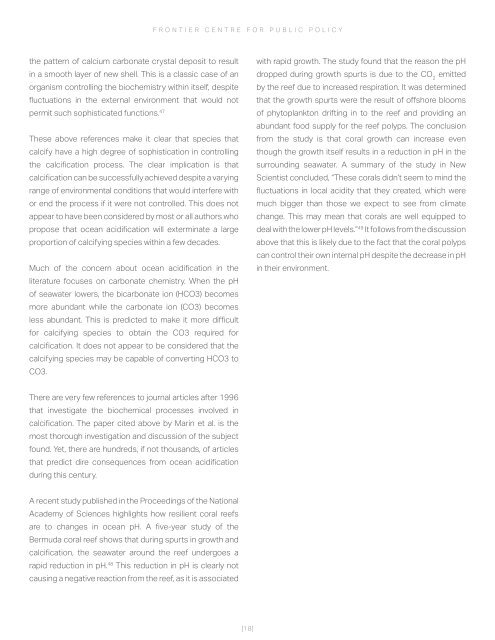OCEAN “ACIDIFICATION” ALARMISM IN PERSPECTIVE
rUUhYH
rUUhYH
You also want an ePaper? Increase the reach of your titles
YUMPU automatically turns print PDFs into web optimized ePapers that Google loves.
FRONTIER CENTRE FOR PUBLIC POLICY<br />
the pattern of calcium carbonate crystal deposit to result<br />
in a smooth layer of new shell. This is a classic case of an<br />
organism controlling the biochemistry within itself, despite<br />
fluctuations in the external environment that would not<br />
permit such sophisticated functions. 47<br />
These above references make it clear that species that<br />
calcify have a high degree of sophistication in controlling<br />
the calcification process. The clear implication is that<br />
calcification can be successfully achieved despite a varying<br />
range of environmental conditions that would interfere with<br />
or end the process if it were not controlled. This does not<br />
appear to have been considered by most or all authors who<br />
propose that ocean acidification will exterminate a large<br />
proportion of calcifying species within a few decades.<br />
Much of the concern about ocean acidification in the<br />
literature focuses on carbonate chemistry. When the pH<br />
of seawater lowers, the bicarbonate ion (HCO3) becomes<br />
more abundant while the carbonate ion (CO3) becomes<br />
less abundant. This is predicted to make it more difficult<br />
for calcifying species to obtain the CO3 required for<br />
calcification. It does not appear to be considered that the<br />
calcifying species may be capable of converting HCO3 to<br />
CO3.<br />
with rapid growth. The study found that the reason the pH<br />
dropped during growth spurts is due to the CO 2<br />
emitted<br />
by the reef due to increased respiration. It was determined<br />
that the growth spurts were the result of offshore blooms<br />
of phytoplankton drifting in to the reef and providing an<br />
abundant food supply for the reef polyps. The conclusion<br />
from the study is that coral growth can increase even<br />
though the growth itself results in a reduction in pH in the<br />
surrounding seawater. A summary of the study in New<br />
Scientist concluded, “These corals didn’t seem to mind the<br />
fluctuations in local acidity that they created, which were<br />
much bigger than those we expect to see from climate<br />
change. This may mean that corals are well equipped to<br />
deal with the lower pH levels.” 49 It follows from the discussion<br />
above that this is likely due to the fact that the coral polyps<br />
can control their own internal pH despite the decrease in pH<br />
in their environment.<br />
There are very few references to journal articles after 1996<br />
that investigate the biochemical processes involved in<br />
calcification. The paper cited above by Marin et al. is the<br />
most thorough investigation and discussion of the subject<br />
found. Yet, there are hundreds, if not thousands, of articles<br />
that predict dire consequences from ocean acidification<br />
during this century.<br />
A recent study published in the Proceedings of the National<br />
Academy of Sciences highlights how resilient coral reefs<br />
are to changes in ocean pH. A five-year study of the<br />
Bermuda coral reef shows that during spurts in growth and<br />
calcification, the seawater around the reef undergoes a<br />
rapid reduction in pH. 48 This reduction in pH is clearly not<br />
causing a negative reaction from the reef, as it is associated<br />
[18]


